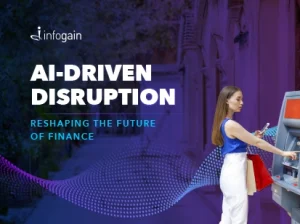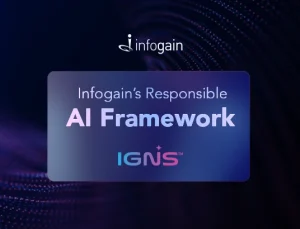- Posted on : February 5, 2018
-
- Industry : Corporate
- Type: News

Authored By: Sumit Sheth, Head, Creative Imagineering, Infogain
Design Thinking (DT) is a methodology used by designers for solving complex problems and identifying suitable solutions for consumers or end-users. In simple words, this human-centred process of innovation emphasises on what consumers would love to have and prevents organisations from making dicey instinctive bets by helping them understand what their potential customers really want.
The concept of DT has been gaining grounds in a wide array of industries as it can be applied to business, service, and product design. The IT industry too should embrace DT as it enables businesses to consider a bigger picture to understand end-to-end user- experience, thus helping them deal with new challenges about their products and services.
However, Design Technology should not be confused with Agile. DT is a design-led approach to innovation meant for delivering durable and user-friendly products. It is applied tactically by means of design methods for identifying the answers to the right questions.
Agile, on the other hand, is a methodology used operationally while developing software. Both the methodologies involve prototyping and iteration as well as ongoing modifications. However, the most remarkable difference between the two is Design Thinking’s alienation from software.
Design Thinking Emphasizes a Goal, not on Problem-Solving
DT is not problem-focused but it emphasizes on finding desirable goals by drawing upon intuition, logic, and imagination for creating the required outcomes so as to benefit the end-user. Design principles is an official procedure for inventive resolution of challenges and conception of solutions with the objective of coming up with better future products.
Thus, it is termed as a form of solution-focused thinking that begins with a goal of creating an improved future situation rather than a problem-solver. DT, when applied to strategies can significantly improve the success rate of innovation.
Design Thinking Methodology
In order to come up with more sophisticated solutions, DT focuses on a human-centric approach and cognitive empathy that depends on connecting intuition, motivation, and sentiments for making improved solutions by taking business practicability and technological viability into consideration.
Since the Design Thinking approach is user-centred, its aim is to comprehend the needs of end-users across the consumer’s journey which enables marketers to map how to deliver positive customer experience consistently.
DT depicts consumers’ emotional state with the help of a Customer Journey Map consisting of visual elucidation of the overall story from consumers’ perspective of their rapport with a brand or an organisation and its offerings, across channels. The components of a customer journey map includes the following—
- Persona or the key characters that exemplify the needs, objectives, emotions, beliefs, expectations and problems of the end-user.
- Touchpoints that illustrate the action of users and their communication with the organisation; and
- Channels that demonstrate the source of interaction— e.g., in-store, mobile-app, website, or web-portal.
The initial stage of DT is to examine, recognise, and comprehend the unmet requirements of the target group. The insights derived from the data helps IT experts foresee the required end result which is later considered as the key agenda. Design-thinking keeps its goals focused on end users as the goals propel the purpose of the project.
The next stage is to define the challenge pertaining to design or any other problem in a human-centred way so that the research team can proceed towards the right direction in the subsequent stages.
In the ideating stage, the team takes measure to identify innovative solutions to the challenges. In the next stage, i.e., the prototyping phase, scaled down adaptations of the product are crafted and tested so that the design can be validated. Gradually, the solutions are approved, improved or re-evaluated on the basis of user experience.
The final stage of DT reveals the real comprehension of the consumers’ interaction with the product. In the final stage, the best solutions identified by the team in the previous stage are utilised for testing and retesting the product in an iterative style, and the design undergoes alterations and modifications.
Why do Enterprise IT needs to Adopt Design Thinking?
Though DT is making waves across industries, it is definitely a new concept that the IT sector is yet to embrace. DT has the potential to redefine the future of technology industry by enhancing product innovation and improving customer experience; thus, tech giants like Apple, Microsoft, and few others are already using this framework to enhance their competitiveness. For instance, last year, Microsoft had revealed that they are deploying this methodology for coming up with enhanced products keeping the needs of the disabled in mind.
While DT has been adopted widely in product design, it has seen only moderate acceptance by enterprise IT. For example, IBM, the enterprise software company makes use of this tactic to surpass the inexorable improvement in digital technology. However, improvements in user experience could be accelerated if IT leaders adopt DT approaches extensively.
Digital transformation projects at the enterprise level can grasp remarkable benefits by implementing Design Thinking approach. Product design is predominantly crucial in the enterprise IT industry as the Millennial users look forward to designs that are flawless and insightful. However, with the advancement of technology, designing enhanced products has become more complicated, as product designers need to keep multiple factors in mind, such as the mobile phone, desktop, network effects, and so on.
Thus, enterprise IT needs to embrace the concept of Design Thinking as it can deal with challenges that are unknown or indistinct. Consequently, it can help enterprise IT to improve product innovation so as to offer better customer experience.
Design Thinking Is Ideal for Digital Transformation
DT is emerging as the core component for the success of digital transformation as it emphasises on data-driven innovation and embraces the fact that no disruptive innovations can be made without considering the needs of consumers.
In order to succeed in today’s digital age, organisations need to unlearn the conventional methods of working and become accustomed to the ever-changing needs of a business. Currently, customer behaviour and preferences are changing terrifically, thereby, boosting the importance of multi-channel integration along with customer-dialogue management and customer experience management.
Since technology has become a crucial tool for fulfilling the needs of consumers, organisations must utilise digital solutions for retaining existing customers as well as for developing strong customer relationships. This is why many organisations implementing digital initiatives for transforming their business are incorporating DT as an essential part of their corporate strategic programmes.
DT approach is crucial for IT organisations as real innovation can happen only when technology, marketing and consumer needs are synthesized. However, there are certain challenges that IT companies have to face while making this shift.
For example, IT organisations should identify the actual requirements of the business and learn about the need of the consumers before utilising the gathered information for creating hi-tech solutions.
At the same time, IT experts should partner with businesses in order to engage themselves in strategic business discussions as it gives them the opportunity to delve deeper into understanding the end consumers. Strategic discussions also go a long way in helping them learn about new technology solutions along with the ways and means of implementing them, thus ushering in a digital revolution.
News Originally Posted on: PCQUEST






